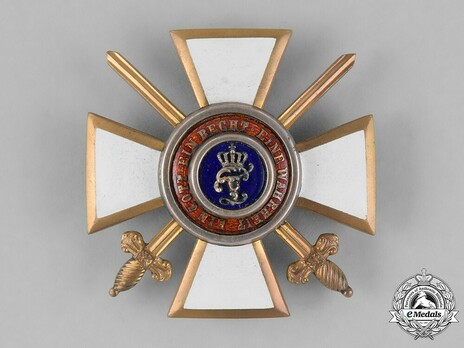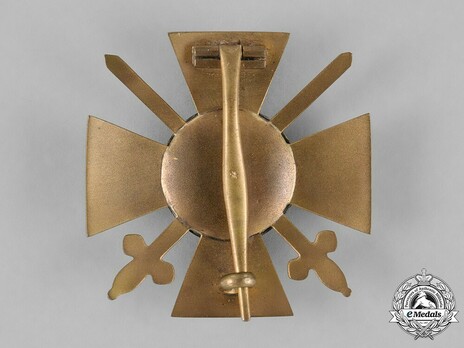House Order of Duke Peter Friedrich Ludwig, Military Division, Officer (in bronze gilt)
CATEGORY: Version
SKU: 01.OLD.0101.207.01.001
Estimated market value:


Estimated market value:
A cross pattée constructed of gilt bronze, with white enameled arms, and with gilt crossed swords between the arms of the cross; the obverse with a central blue enameled medallion depicting a gilt crowned cipher of Peter Friedrich Ludwig, surrounded by a gilt ring of red enamels, inscribed Ein Gott-Ein Recht-Eine Wahrheit (One God, One Righteousness, One Truth); the reverse plain, with a branjo style pinback, with a barrel hinge and a broad catch; marked with a star, indicating bronze manufacture; measuring 43.58 mm (w) x 43.52 mm (h); weighing 19.3 grams; in better than very fine condition.
The House Order of Duke Peter Friedrich Ludwig was instituted by Grand Duke Paul Friedrich August of Oldenburg in commemoration of his father, Duke Peter Friedrich Lodwig. It was conferred in recognition of both civil and military merit.
The order was separated into two divisions; each division featured the same awards, but they were allotted different number of members.
The first division or “die Kapitulare” was limited to members of the Oldenburg family. The chapter had an associated badge, which was a medallion surrounded by an enamelled green wreath. The badge came in numerous grades, which affected the composition.
The second division was composed of honorary members. This division of the order was allowed to confer twice as many awards.
All grades of the order, except for the Gold, Silver, and Bronze Medals, could be awarded with crossed swords to denote military merit.
If an individual had previously received a lower-grade award with swords, and later received a higher grade without swords, they wore “swords on ring” on the higher grade.
In 1918, a further provision for a wreath of laurels was added to the order. The wreath was conferred for war merit.
The order became obsolete in 1918 when the last Grand Duke of Oldenburg abdicated.
The Officer’s Cross was added to the order in 1903. It differs from the other medals of the order as it features a pinback fastening device, as well as a blank reverse.

Comments
Sign in to comment and reply.


Scroll Top